|
Advertisement
|
English for Everyday Living
|
|
| To order these lessons on a CD, floppy disk,or in print, go to the Order Page. |
SUPAPORN NILAYAKANON THANKS FOR ALL>. |
Your Body, Page 1
Go to Your Body, Page 2
Your body has many parts, from the hair on the top of your head to the toes at the end of your foot. This lesson will teach you the names of those parts using pictures of real people as illustrations. (Editor's Note: Some parts of your body are personal and private, and therefore will not be included in this lesson. We understand that it is important to know the English names of ALL your parts in order to be able to tell a doctor about any problems you might have with those parts. For that reason, the names of those parts, with illustrations from a medical book, will be sent to you via e-mail if you send us a request.)
The human body can be described in many different ways depending on its size and shape. A thin body can be scrawny, slim, skinny, slender, bony or emaciated. (Look in your English/Your Language dictionary to find definitions of these words.) A heavy body can be fat, plump, obese, chubby, stocky or corpulent. Between these extremes are bodies that are shapely, curvaceous, svelte, athletic, average (for women) or trim, rangy, muscular, athletic, average (for men). A person can be tall, short or of average or medium height.
The Human Head
A normal human head has hair covering its top, rear and upper sides. It has two ears, one on each side of the head. The front of the head is called a face. A face consists of a forehead across the top of the face, two eyebrows at the bottom of the forehead, and two eyes, one under each eyebrow. Beginning between the eyes and extending downward is a nose. The nose has two openings at the bottom called nostrils. On either side of the nose are your cheeks. Below the nose are the upper and lower lips. The lips guard an opening called a mouth. Inside the mouth are top and bottom teeth which grow out of the gums. Growing from the bottom center of the mouth is a tongue. Behind the tongue is an opening called a throat which leads to the lungs and the stomach. Under the mouth is the front part of your lower jaw called a chin.
The head is connected to the rest of the body by the neck. In the front of the neck is a bump called your Adam's apple or voice box. This bump is much more noticeable in men than in women.
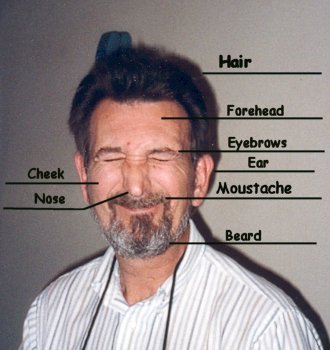 |
 |
| Hair terms
Hair can be straight, wavy, curly or kinky.
Hair can be blond, brown, black, gray, white or red. These colors can be divided into honey blond, strawberry blond, dirty blond, mousey brown, reddish-brown (auburn), grizzled (like the beard above), salt-and-pepper.
Hair can be long or short or medium length. It can be close-cropped or shoulder-length. It can be permed, teased, dreadlocked, styled or natural.
Many people, mostly females, change the color of their hair. They dye their hair or color their hair to give themselves a different appearance or to cover gray or white hair.
The person in the picture above has dark brown hair. (A woman with brown hair is called a brunette.) The hair above is slightly wavy and medium-length. The person also has a neatly-trimmed moustache and a grizzled beard.
|
Face terms
Faces come in various shapes. They can be oval, heart-shaped, round or square. Faces can be described as being beautiful, pretty, striking, cute, interesting, handsome, average, plain, homely or ugly,
There are many muscles in your face that allow you to form many different expressions. By moving or tensing the muscles of your jaw, your lips, your eyes, your forehead and other parts of your face, you can look happy, sad, excited, curious, angry, bored, afraid, loving or worried.
Usually our faces form these expressions on their own, based on the feelings we have at the moment. Actors, politicians and some criminals learn to form various expressions with their faces that are not related to their emotions. That makes it difficult for others to know for sure what they are really thinking or feeling.
Some people claim to know what a person is thinking or feeling by the look in his eyes, but the eyes do not change. What people really notice is the tiny changes in the rest of the face that surround the eyes.
|
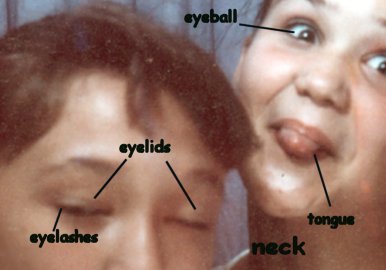 |
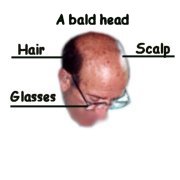 |
|
Your eyes have many different parts. Your eyelids are the skin coverings that slide down over your eyeballs when you blink. Eyelashes are short, curved hairs that grow from the bottom edge of your eyelids. Eyebrows are the short, curved hairs that grow above your eyelids. The colored part of your eyeballs is called the cornea. Corneas can be blue, green, brown, yellow, or a combination of colors. The pupil is a black dot in the center of your cornea. The pupil grows larger when the light is dim and smaller when the light is bright.
|
A person with no hair on his head is said to be bald. If there is hair on some parts of the head but not on others, that person is partially bald. A person who is loosing his or her hair over a period of time is said to be balding.
The glass or plastic lenses set in metal or plastic frames and supported by the nose and ears are called glasses, eyeglasses or spectacles. If the lenses have two or three sections in them, they are called bifocals or trifocals. Lenses that are placed directly on the eyeball are called contacts or contact lenses.
|
THANKS FOR ALL. Supaporn Nilayakanon Tew2497@hotmail.com
วันที่ 23 มี.ค. 2552
🖼สำหรับคุณครูไว้ใส่เกียรติบัตรสวยและถูก🖼 กรอบป้ายอะคริลิคตั้งโต๊ะ A4 แนวนอน 30x21.5 cm อะคริลิคใส 1 หน้า ทรง L (A4L1P) ในราคา ฿129 คลิกเลย👇👇https://s.shopee.co.th/1qLFIZVf4t?share_channel_code=6
Advertisement

เปิดอ่าน 7,173 ครั้ง 
เปิดอ่าน 7,155 ครั้ง 
เปิดอ่าน 7,161 ครั้ง 
เปิดอ่าน 7,191 ครั้ง 
เปิดอ่าน 7,180 ครั้ง 
เปิดอ่าน 7,171 ครั้ง 
เปิดอ่าน 7,160 ครั้ง 
เปิดอ่าน 7,222 ครั้ง 
เปิดอ่าน 7,198 ครั้ง 
เปิดอ่าน 7,161 ครั้ง 
เปิดอ่าน 7,168 ครั้ง 
เปิดอ่าน 7,171 ครั้ง 
เปิดอ่าน 7,166 ครั้ง 
เปิดอ่าน 7,159 ครั้ง 
เปิดอ่าน 7,157 ครั้ง 
เปิดอ่าน 7,159 ครั้ง |

เปิดอ่าน 7,372 ☕ คลิกอ่านเลย |

เปิดอ่าน 7,159 ☕ คลิกอ่านเลย | 
เปิดอ่าน 7,203 ☕ คลิกอ่านเลย | 
เปิดอ่าน 7,202 ☕ คลิกอ่านเลย | 
เปิดอ่าน 7,169 ☕ คลิกอ่านเลย | 
เปิดอ่าน 7,174 ☕ คลิกอ่านเลย | 
เปิดอ่าน 7,164 ☕ คลิกอ่านเลย |
|
≡ เรื่องน่าอ่าน/สาระน่ารู้ ≡ 
เปิดอ่าน 24,799 ครั้ง | 
เปิดอ่าน 90,850 ครั้ง | 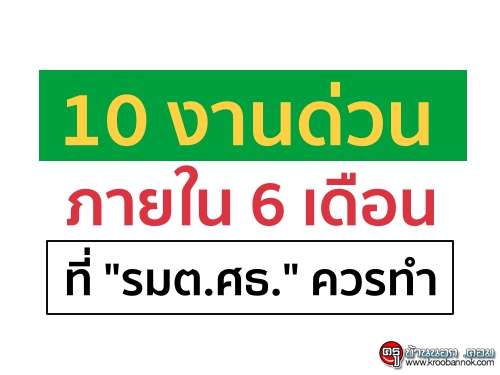
เปิดอ่าน 18,791 ครั้ง | 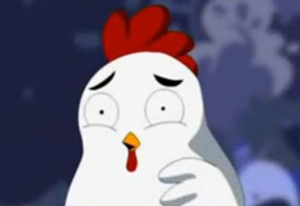
เปิดอ่าน 20,215 ครั้ง | 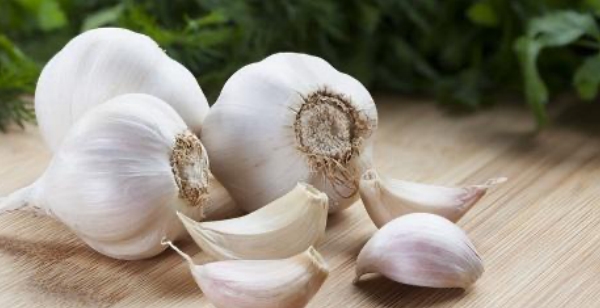
เปิดอ่าน 16,980 ครั้ง |
|
|








